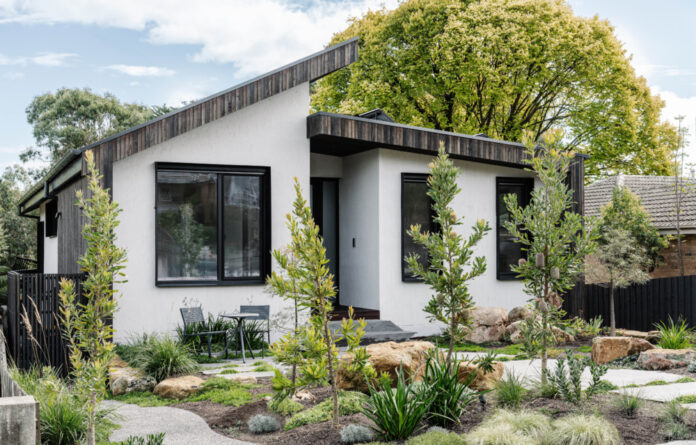A Family’s Sustainable Sanctuary, Built From Biodegradable Material
Sustainable Homes

The facade of the Viewbank home.

The orientation of the house was carefully planned to optimise natural light and solar gain.

Rustic shiplap cladding made from silvertop ash timber features on the exterior.

The light-and-bright living room.

Garden views.

The hempcrete walls were finished with a light lime render.

Polished concrete floors are paired with warm timber joinery.

One of the bedrooms.

The pared-back interiors were another deliberately sustainable choice.

Light colours have been used to make the spaces feel open and airy.


Productive gardens envelop the property.


The brief also asked for self-contained studio to comfortably accommodate extended visits from their family members living overseas or interstate.

The landscaping features natives like brachychiton trees, banksia serrata, and a diverse mix of plant species that support local wildlife.
When Nelson and Amanda set out to build a replacement for their old and leaky Viewbank home, ensuring its sustainability was front of mind.
‘They were after timeless design that fits into the surrounding neighbourhood and should not be ostentatious,’ Gruen Architecture co-founder and certified passive house designer, Simone Schenkel says. ‘Every room had to be just big enough for its purpose, no bigger, and having no wasted or under-utilised space was also very important for them.’
This emphasis on the environment is reflected in everything, from the native gardens that envelop the new house, to its pared-back interiors, and the use of innovative building material ‘hempcrete’ for the home’s construction.
Simone says the couple were inspired after visiting the Kyneton hempcrete house of Joe D’Alo, founder of Hemp Building Company. They were drawn to the health benefits of the non-toxic composite material (made of hemp, sand, and a hydraulic binder), which also offer excellent thermal comfort, and help to passively regulate the home’s temperature.
‘The concept of hempcrete being breathable while simultaneously rendering an airtight finish on both sides made it the perfect choice for creating a healthy, low-carbon Passive House,’ Simone explains.
Hamish White of Sanctum Homes handled the build, reinforcing the hempcrete with a textural lime-render finish, enhanced by the polished concrete floors in the living areas and timber features. He says it took more than a few goes to get the structure airtight in line with the Passive House standards, but now Nelson and Amanda get to enjoy the home’s maximised comforts, and reduced energy bills, thanks to a 10.7kWh system of solar panels.
The 8.2-star house is also all-electric, and is relatively compact in size – leaving more room for the gardens, which the family of five have made the most of, with veggie patches, fruit trees, and rainwater harvesting.
‘This home offers a harmonious blend of nature and architecture,’ Simone says. ‘From the use of reclaimed materials and recycled materials, to the incorporation of edible bush tucker plants in the garden, each thoughtful element adds a sense of connection with nature and a deeper appreciation for sustainable living.’
She notes that everything has been designed to serve the family who live here, across their ‘entire lifespan’. But the best part is, when the the building reaches the end of its lifecycle, the ingredients that make up hempcrete can be broken down and re-used, or ‘disposed’ back into nature itself.
Want to see more from The Design Files? Sign up to our newsletter for your daily or weekly dose of home and design inspiration!
thedesignfiles.wpenginepowered.com










